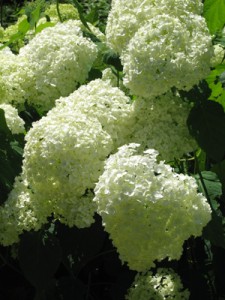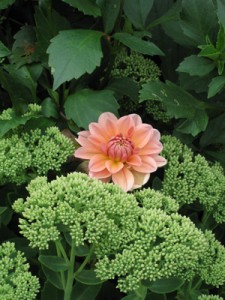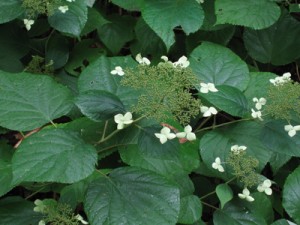Celebrating Small Flowers
February 6, 2011 by admin
Filed under In the News, Plant Rant
This post marks the first time my blog also appears in the Christian Science Monitor online. Their Diggin’ It feature is a great place to read the thoughts and opinions of garden bloggers from around the country, and I hope to contribute on a regular basis.

Hydrangea 'Annabelle' is a bit too, well, buxom
For as long as people have been growing plants for beauty instead of utility, plant breeders have had an obsession with developing ever bigger flowers. Within reason, that’s understandable. Sometimes, there’s no harm in having a little more of something you like (I’m thinking blueberry pie). But there comes a point with any good thing at which more is just too much.
Today, nurseries are full of plants with flowers so enormous and weighty they literally can’t hold themselves up. I mean, if Hydrangea arborescens ‘Annabelle’ were a person, she’d be a candidate for breast reduction surgery on grounds of medical necessity.
Plant breeders aren’t the only ones to blame, of course. Someone had to buy all those oversized horticultural wonders. I’m not pointing fingers, but you know who you are. (And I admit that I’m one of them, although I’m recovering.)
Well, I’m here today to celebrate the (sometime) superiority of small flowers.
Consider the peony. Nearly every Paeonia lactiflora (the common herbaceous peony—the plant most people think of when you say “peony”) you can find at a retail nursery will have gigantic bombe-type flowers. They’re upwards of six inches across and fully double with hundreds of petals. When open, they weigh so much that their stalks will bend or break, leaving the flowers in the dust, as a result of a decent rain or a good gust of wind. In other words, all it takes is some normal weather to cause them to collapse.
Peony hoops really aren’t much help. They just cause the stalks to bend and break above the level of the hoop, as opposed to lower down. Staking methods that attempt to solve this problem, such as a circle of chicken wire, are (in my opinion) ugly and time-consuming. I’m looking more for “attractive and easy” gardening methods, or better yet, “do nothing at all” methods.

My "Goldilocks" dahlia—just the right size
I just don’t understand why people put themselves through this when, by growing single peonies, they could avoid the problem altogether. Take a look at these beautiful single peonies from Hidden Springs Flower Farm. At most, these plants need a single hoop encircling the whole clump just to hold them upright in case of some really severe weather.
Dahlias are pretty much the same story. Certain dark forces in the world of horticulture would have you believe that so-called “dinner plate” dahlias are the most desirable and obviously worth their premium price. You’ll never catch me buying them, though. My favorite dahlia is this unidentified orange one pictured at left that a client in my garden design business shared with me many years ago. Its flowers are about three inches across and perfect for flower arrangements because they’re in scale with black-eyed Susans and other perennials that flower in mid to late summer when the dahlia does. I see similar ones in catalogs all the time…usually at a cheaper price than their overgrown relatives. Yes, the plant as a whole requires a great big tomato cage, but the individual stems are perfectly capable of holding up the flowers without additional support.

Hydrangea arborescens ssp. radiata holds up its head in all kinds of weather
I mentioned Hydrangea arborescens ‘Annabelle’ already. I still grow her, but she is a handful. I’d much prefer a cultivar with flowers about half the size, but wishing doesn’t make it so. (I’m not the only one. Read blogger Tim Wood’s extensive ramblings about hydrangeas here.) One alternative is to grow the species or its subspecies, H. a. ssp. radiata, both of which produce lacecap floral displays instead of foot-wide snowballs. (There are many other lacecap types, but they won’t bloom reliably in Zones 5 and colder.) These choices won’t fall to pieces after a summer downpour.
My message here is that bigger is not necessarily better. Supersize flowers can come with supersize maintenance requirements. That doesn’t make them bad…just more work. As the old saying goes, “the bigger they are, the harder they fall,” and that’s enough of a reason for me to celebrate small flowers.


My thoughts precisely! In fact I thought I was just about the only one who disdains the “dinnerplate dahlia” in favor of smaller ones, no more than 6″ across. Bought one by mistake a few years ago, and it does give you tons of “oohs and aahs” from your friends, but it so quickly dominates a flower arrangement that I don’t want to bother with it. I love your unintended suggestion to use tomato cages for my 4′ tall dahlias! That should be a whole lot more effective than the staking I try to do–it’s nearly impossible to get a stake into the ground deep enough to hold up a mature dahlia plant. So thanks for that!
For peonies, you can’t beat the old ones that came with the last place I lived: fully double but not huge and incredibly prolific, able to hold up almost every single flower just fine, thank you. The plants were so huge I assumed they had to be over 30 years old. Took some divisions when I moved 3 years ago. The young-uns are doing well, though not as sturdy as their mamas yet.
Well, I don’t disdain big dahlias. I even like staking, as garden jobs go, but not that kind of staking. I just wanted to mention that I do one additional thing to help support big plants: I “weave” a thick bamboo pole between the cross-pieces of the tapered, circular tomato cages, pushing it as deeply into the ground as I can get it before setting the cage itself into the soil. For exceptionally large plants, I’ll use two or three poles. These just give extra rigidity to the whole assembly, especially since the wire legs of tomato cages are never long enough to anchor them as securely as large plants demand. In spring, I think I’ll do a blog post about planting dahlias so you can see what I mean.